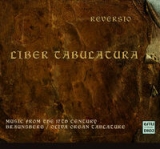Das Kammermusikensemble Reversio macht einerseits das, was auch andere dieser Art und Güte machen, es spielt Alte Musik, also der Renaissance und des Barock, auf historischen Instrumenten. Andererseits haben sie auch die besondere Note. Denn sie verwenden dazu auch alte lokale, der Ethnologe oder der Önologe würden sagen autochthone, der Biologe endemische, Instrumente.
Dazu gehört etwa das litauische Birbynė. Dabei handelt es sich um ein ursprüngliches litauisches Holzblasinstrument mit ausdrucksstarken und kontrastreichen Klängen. Mit anderen Instrumenten der Zeit wie Kornett bzw. Zink, der Blockflöte, der Barockoboe und dem Chalumeau weist es erstaunliche Ähnlichkeiten auf. Aber es würzt auch ungehörte Nuancen und Farben bei, so dass neue höreindrücke für die Werke entstehen.
Nun haben sie aus zwei Sammlungen von Musikmanuskripten, die unter dem Namen Braunsberg/ Oliva tablaturas geführt werden, Werke aus dem ersten Konvolut eingespielt. Namensgebend waren die Entstehungsorte der Kompositionen, nämlich Braunsberg und das Kloster Oliva, heute Braniewo und das Kloster Oliva nahe Gdansk. Der Begriff Tabulatura nennt dabei die Notationsart, die Griffzeichenschrift. Der verbindende Name ist Jakobus Apfell, der sowohl in Braunsberg wie auch im Kloster Oliva, dort als Abt, lebte und auch auf den Manuskripten genannt wird. Aus den mitgelieferten Informationen im Heft ergeben sich ausführliche informative Hinweise auf die Komponisten und die Werke.
Das Reversio Ensemble hat 41 der 308 Kompositionen ausgewählt. Mit einem gewissen Schwerpunkt auf Tänzen haben die Musiker aus dem reichhaltigen Fundus an Formen und Inhalten ihre Auswahl getroffen. In ebenso eloquenter wie technisch prägnanter Weise eröffnen sie diesen Kosmos. Bei den Tänzen fällt auf, dass viele eher im Schreittempo als besonders schnell erklingen.
Reversio bietet nicht nur unterschiedliche Musik an, sondern stellt sie auch in variantenreicher und lebendiger Interpretation vor. Mal stehen die Bläser im Vordergrund, dann bildet das Schlagwerk das akustische Zentrum, woanders haben Cembalo oder Orgel ihren prominenten Auftritt. So zeigen sie eine bunte, aber nicht wahllose, Mischung, die den Zuhörer sofort in eine vergangene Zeit versetzt und diese ins Jetzt zurückruft.
On the one hand, the chamber music ensemble Reversio does what others of this type and quality do: it plays early music, i.e. Renaissance and Baroque, on historic instruments. On the other hand, they also have a special touch. Because they also use old local instruments – ethnologists or oenologists would say autochthonous, biologists would say endemic.
These include the Lithuanian birbynė. This is an original Lithuanian woodwind instrument with expressive and contrasting sounds. It has astonishing similarities with other instruments of the time such as the cornet or cornet, the recorder, the baroque oboe and the chalumeau. But it also adds unheard nuances and colors, creating new auditory impressions for the works.
Now they have recorded works from the first set of two collections of music manuscripts, which are listed under the name Braunsberg/ Oliva tablaturas. The names were inspired by the places where the compositions were written, namely Braunsberg and the Oliva monastery, today Braniewo and the Oliva monastery near Gdansk. The term tabulatura refers to the type of notation, the fingering. The connecting name is Jakobus Apfell, who lived both in Braunsberg and in Oliva Monastery, where he was abbot, and is also named on the manuscripts. The information included in the booklet provides detailed information about the composers and the works.
The Reversio Ensemble has selected 41 of the 308 compositions. With a certain focus on dances, the musicians have made their selection from the rich pool of forms and content. They open up this cosmos in a manner that is as eloquent as it is technically concise. It is noticeable that many of the dances are played at a walking tempo rather than particularly fast.
Reversio not only offers different music, but also presents it in varied and lively interpretations. Sometimes the wind instruments are in the foreground, then the percussion forms the acoustic center, elsewhere the harpsichord or organ make their prominent appearance. In this way, they present a colorful, but not indiscriminate, mixture that immediately transports the listener to a bygone era and calls it back to the present.






















